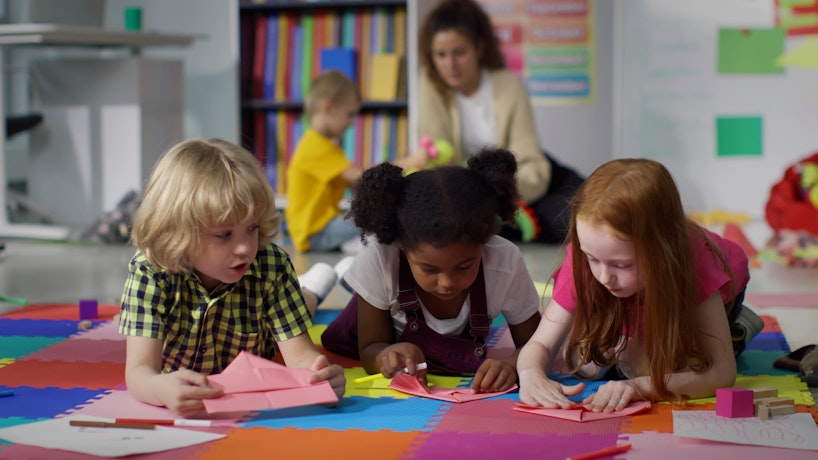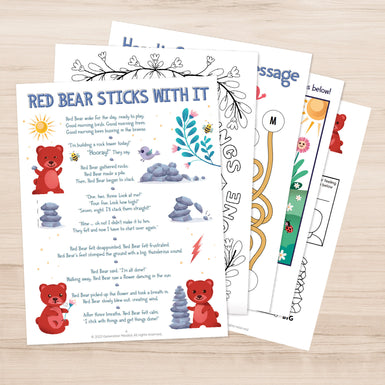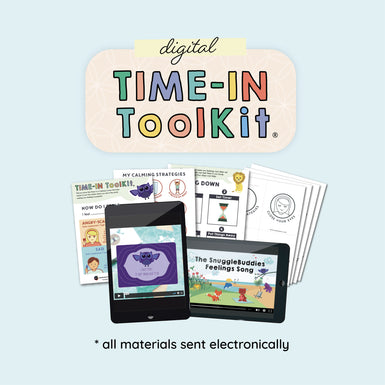Are you ready to dive deep into the heart of educational magic, where growth knows no bounds and potential is limitless?
"Every child deserves a champion – an adult who will never give up on them, who understands the power of connection and insists that they become the best that they can possibly be." - Rita Pierson
Within the captivating realm of early childhood development live five widely embraced domains. When woven together in the early childhood classroom, like a beautiful tapestry, these learning experiences inform and support the future life happiness and success of the whole child as opposed to their intellectual development alone.
Join me on this journey through all five domains as I share insights from my experience as a former preschool teacher.
Cognitive Development:
Nurturing the physical domain of cognitive development in early childhood is essential for helping children develop their problem-solving abilities, spatial awareness, and fine motor skills. Here are ten activities for early childhood educators to incorporate into their classrooms to promote physical aspects of cognitive development:
- Puzzle Play: Provide a variety of age-appropriate puzzles with different shapes, sizes, and complexities. Puzzles help children develop spatial reasoning, problem-solving skills, and fine motor coordination.
- Building with Blocks: Offer building blocks of various materials, such as wooden, foam, or magnetic blocks. Encourage children to construct structures, fostering spatial understanding and creativity.
- Shape Sorters: Provide shape sorting toys where children match objects to corresponding holes. This activity enhances shape recognition, hand-eye coordination, and problem-solving.
- Pattern Recognition: Create pattern cards or use patterned materials like beads or buttons. Children can replicate and extend patterns, enhancing their cognitive and fine motor skills.
- Sensory Bins: Fill sensory bins with materials like rice, sand, or beans. Add small objects or toys for children to find and sort. This activity stimulates tactile exploration and cognitive development.
- Threading and Lacing: Offer materials for threading and lacing, such as beads, buttons, or foam shapes. These activities improve fine motor skills and hand-eye coordination while fostering focus and patience.
- Mazes and Labyrinths: Provide maze or labyrinth puzzles with varying degrees of complexity. Children can maneuver through these puzzles, enhancing their problem-solving and spatial awareness.
- Nature Exploration: Take children on nature walks to observe and collect leaves, rocks, or other natural items. Encourage discussions about what they find to foster observation and critical thinking skills.
- Cooking and Baking: Involve children in simple cooking or baking activities. They can follow recipes, measure ingredients, and observe the transformation of materials, promoting cognitive and math skills.
- Science Experiments: Conduct age-appropriate science experiments, such as mixing colors or exploring simple chemical reactions. These hands-on activities stimulate curiosity and critical thinking.
Educators can future support this domain by providing a supportive environment, exploration, problem-solving, and hands-on experiences that spark curiosity. It is also important that these activities are age-appropriate and adapted to the developmental level of every child in the classroom.
Social and Emotional Development:
Nurturing the physical domain of social and emotional learning (SEL) in early childhood is vital for helping children develop self-awareness, self-regulation, and interpersonal skills. By cultivating these skills in the classroom, children not only develop the capacity to express their feelings, but the skills they need to establish healthy relationships, including the capacity to set boundaries, empathize with others, and be resilient in the face of a challenge.
Children as young as ages 2 and 3 years of age can learn how to identify and "manage" their feelings by practicing strategies for emotional regulation. Using time-in's and other responsive rather than punitive methods transforms challenging moments into learning moments.
Here are ten activities for early childhood educators to incorporate into their classroom to promote SEL:
- Emotion Charades: Have children take turns acting out different emotions through facial expressions and body language. This activity helps them recognize and understand emotions in themselves and others.
- Yoga and Mindfulness: Introduce simple yoga poses and mindfulness exercises. These activities promote body awareness, relaxation, and emotional self-regulation.
- Emotion Cards: Create emotion cards with pictures of various facial expressions. Encourage children to identify and match the emotions on the cards, fostering emotional recognition.
- Breathing Exercises:
Teach deep breathing techniques to help children calm themselves when they are upset or anxious. Practicing deep breaths physically relaxes the body.
- Emotion Stones: Paint rocks with different facial expressions representing various emotions. Children can hold these stones when discussing their feelings, offering a tangible way to connect emotions with the physical world.
- Group Art Projects: Collaborative art projects, such as painting a mural or creating a friendship quilt, promote teamwork, sharing, and a sense of belonging.
- Feelings Faces Poster: Hang a poster with various emotions and facial expressions. During group discussions, encourage children to point to the emotion that best represents their feelings.
- Positive Affirmations: Incorporate daily positive affirmations or self-talk exercises. Encourage children to use positive physical gestures like placing their hands on their hearts while saying affirmations to boost self-esteem.
- Empathy Circle: Form a circle and have children take turns sharing something that makes them happy or sad. Encourage peers to offer supportive physical gestures like hugs or pats on the back.
- Conflict Resolution Role-Play: Create scenarios where children can practice resolving conflicts through role-play. This physical interaction helps them develop problem-solving and communication skills.
This domain is pivotal for parents, caregivers, and educators to incorporate in early learning if we are to raise a generation of resilient and compassionate kids.
Physical Development:
Little ones are always on the move, and physical development is the cornerstone of their growth. Gross motor skills like jumping, running, and climbing occur on the playground or in designated spaces. Fine motor skills are essential for activities like writing or drawing activities including this beautiful coloring page that builds self-esteem in young children in addition to building their fine motor skills. Balancing gross and fine motor skills ensures children develop strength and coordination.
Here are ten activities for early childhood educators to incorporate into their classroom to promote physical development:
- Outdoor Play: Provide ample opportunities for outdoor play, such as running, jumping, climbing, and exploring nature. Outdoor activities enhance gross motor skills and physical coordination.
- Dance and Movement: Encourage children to express themselves through dance and movement. Play music and engage in activities like dancing, marching, or yoga to develop balance and coordination.
- Obstacle Courses: Create simple obstacle courses using mats, cones, and tunnels. These courses promote spatial awareness, balance, and problem-solving skills as children navigate through them.
- Sensory Play: Offer sensory experiences like sand tables, water tables, or playdough. These activities help develop fine motor skills and stimulate tactile and sensory exploration.
- Balancing Games: Set up balance beams, stepping stones, or stability balls to practice balance and coordination. Balancing games are not only fun but also enhance core strength.
- Ball Games: Play games like catch, kickball, or rolling a ball into a target. These activities improve hand-eye coordination and encourage teamwork.
- Bike Riding: If space allows, introduce tricycles or balance bikes. Riding bikes enhances leg strength, balance, and spatial awareness.
- Scavenger Hunts: Organize indoor or outdoor scavenger hunts. This promotes physical activity while engaging children in problem-solving and exploration.
- Yard Games: Incorporate classic yard games like hopscotch, jump rope, or hula hoops. These activities enhance gross motor skills and physical fitness.
- Building with Blocks: Use large building blocks or foam blocks for construction play. This encourages children to manipulate objects, improving fine motor skills and hand-eye coordination.
Remember to create a safe and supportive environment for these activities, and adapt them to the age and developmental level of the children in your classroom.
Language and Communication Development:
Language is the key to unlocking the world around us. Regardless of our language, we need this skill to communicate with others. Early childhood educators create a rich language environment by labeling items, displaying books and posters, focusing on vocabulary words, and more. In this environment, children can express themselves while developing their vocabulary. From babbling babies to chatty preschoolers, every step in learning this skill is celebrated, and every noise is considered communication.
Here are ten activities for early childhood educators to incorporate into the classroom to promote this aspect:
- Storytelling with Props: Use action figures, felt boards, puppets, or plush toys to tell stories. Encourage children to act out parts of the story, helping them connect language with physical actions.
- Role-Play Centers: Set up different role-play areas, such as a kitchen, doctor's office, or grocery store. These scenarios promote communication as children engage in imaginative play and interact with peers.
- Show and Tell: Allow children to bring in an item from home and describe it to the class. This activity builds vocabulary, public speaking skills, and confidence.
- Art and Language: Combine art activities with language development by having children describe their artwork or tell a story related to their creations. This fosters creativity and language skills.
- Dramatic Play: Provide dress-up clothes and props for dramatic play. Encourage children to take on different roles and engage in conversations and storytelling during playtime.
- Rhyming Games: Engage in rhyming games, songs, and chants. Rhymes help children develop phonemic awareness and improve their ability to recognize and produce sounds in words.
- Sensory Letter Recognition: Use sensory materials like sand, rice, or shaving cream to practice letter formation. Children can trace letters with their fingers, reinforcing letter recognition and fine motor skills.
- Language Building Blocks: Use building blocks with letters or words on them. Children can stack the blocks to form words or sentences, promoting early literacy skills.
- Nature Walks and Observation: Take nature walks and encourage children to describe what they see, hear, and feel. This activity enhances observational and descriptive language skills.
- Group Storytelling: Sit in a circle and create a group story, with each child adding a sentence or phrase. This collaborative activity sparks creativity and helps children practice sentence structure and storytelling.
Remember to provide a supportive and encouraging atmosphere where children feel comfortable expressing themselves and using language in various contexts.
Adaptive Development:
Adaptive development refers to the skills children learn self-help and life skills including things like hanging up their bag or putting on their coat (flip-flop-over-the-top!). The preschool years are a crucial stage to develop a sense of independence and the ability to adapt to and navigate the world around them.
Whether it's learning to tie their shoelaces or pour their milk, preschoolers are gaining independence and vital skills for taking care of themselves. Early childhood educators play a vital role in fostering this adaptive development by providing opportunities for self-help skills and encouraging a "can-do" attitude.
Here are ten activities for early childhood educators to incorporate into their classrooms to promote adaptive development:
- Dressing and Undressing: Encourage children to practice dressing and undressing independently. Provide a variety of clothing items with easy closures (buttons, zippers, Velcro) to develop fine motor skills.
- Mealtime Independence: Create opportunities for children to serve themselves snacks or pour their drinks. This helps them develop self-feeding skills and promotes hand-eye coordination.
- Toileting Routine: Establish a regular toileting routine and teach children proper hygiene habits, including handwashing. Support them in using the toilet independently.
- Setting the Table: Involve children in setting the table for snacks or meals. They can learn about the proper placement of utensils and plates while enhancing their fine motor skills.
- Cleaning Up: Teach children to clean up after themselves by putting away toys, books, and art supplies. This fosters responsibility and organization skills.
- Self-Help Stations: Create self-help stations with items like tissues, hand sanitizer, and tissues accessible to children. Encourage them to use these resources independently.
- Shoe Tying Practice: For older preschoolers, introduce shoe-tying activities using oversized shoelaces or practice shoes. This improves fine motor skills and independence.
- Simple Cooking: Involve children in simple cooking activities, like making sandwiches or mixing ingredients for no-bake snacks. Cooking promotes following instructions and fine motor skills.
- Gardening: If you have access to a garden, allow children to participate in gardening activities. They can plant seeds, water plants, and learn about caring for living things.
- Daily Routines Chart: Create a visual daily routines chart with pictures and words to help children understand and follow daily routines. This promotes independence in navigating daily tasks.
Encourage a supportive and patient environment, where children are praised for their efforts and achievements in mastering these adaptive skills.
Why are the domains so important?
Parents, educators, and medical professionals, like pediatricians and occupational therapists, focus on these domains to ensure children meet their developmental milestones. The CDClists developmental milestones, which pediatricians typically assess during well-child exams. For example, one typical milestone in social and emotional development for the average 15-month-old includes clapping when excited.
So, what happens when a child struggles to reach these milestones?
Fortunately, there are resources available for children who may need more encouragement to meet their milestones. Very Well Family states, "Every state in the U.S. offers an early intervention program to support kids under the age of 3 that have developmental delays. Once they are over age 3, the community's local school district must provide programming. So, don't delay determining whether your child needs assistance. There are resources out there to support them should they need it."
Conclusion:
Early childhood education is a harmonious blend of activities and experiences that largely fall into one of these five essential developmental domains. Through patient guidance and positive reinforcement, educators help nurture young minds, empowering our youngest learners with the skills and mindsets they need to embrace new experiences and grow into innovative, knowledgeable, and self-reliant individuals.
By focusing on cognitive, social and emotional, physical, language and communication, and adaptive development, educators prepare children for the exciting journey of life, laying a solid foundation for every child to reach their highest potential for happiness and success.






























